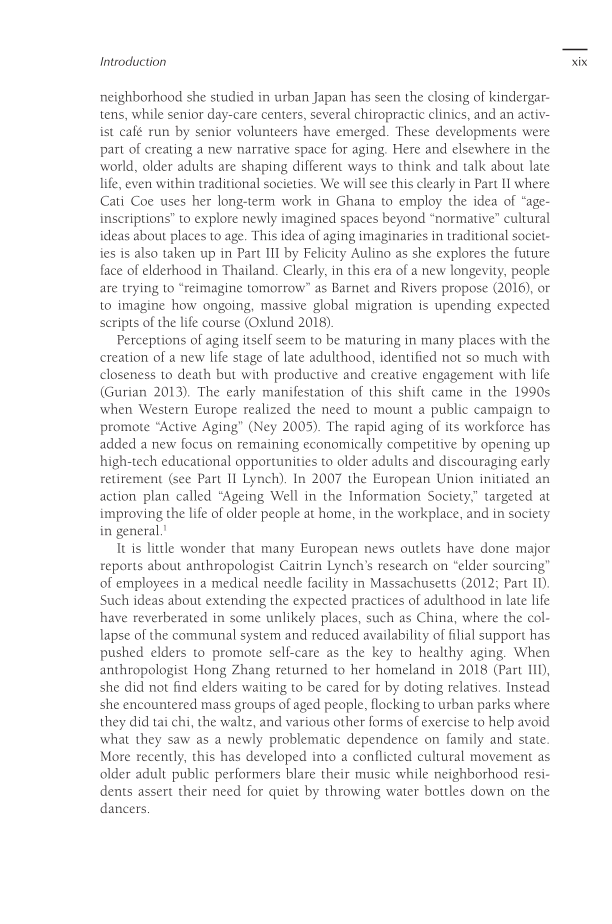Introduction xix neighborhood she studied in urban Japan has seen the closing of kindergar- tens, while senior day-care centers, several chiropractic clinics, and an activ- ist café run by senior volunteers have emerged. These developments were part of creating a new narrative space for aging. Here and elsewhere in the world, older adults are shaping different ways to think and talk about late life, even within traditional societies. We will see this clearly in Part II where Cati Coe uses her long-term work in Ghana to employ the idea of “age- inscriptions” to explore newly imagined spaces beyond “normative” cultural ideas about places to age. This idea of aging imaginaries in traditional societ- ies is also taken up in Part III by Felicity Aulino as she explores the future face of elderhood in Thailand. Clearly, in this era of a new longevity, people are trying to “reimagine tomorrow” as Barnet and Rivers propose (2016), or to imagine how ongoing, massive global migration is upending expected scripts of the life course (Oxlund 2018). Perceptions of aging itself seem to be maturing in many places with the creation of a new life stage of late adulthood, identified not so much with closeness to death but with productive and creative engagement with life (Gurian 2013). The early manifestation of this shift came in the 1990s when Western Europe realized the need to mount a public campaign to promote “Active Aging” (Ney 2005). The rapid aging of its workforce has added a new focus on remaining economically competitive by opening up high-tech educational opportunities to older adults and discouraging early retirement (see Part II Lynch). In 2007 the European Union initiated an action plan called “Ageing Well in the Information Society,” targeted at improving the life of older people at home, in the workplace, and in society in general.1 It is little wonder that many European news outlets have done major reports about anthropologist Caitrin Lynch’s research on “elder sourcing” of employees in a medical needle facility in Massachusetts (2012 Part II). Such ideas about extending the expected practices of adulthood in late life have reverberated in some unlikely places, such as China, where the col- lapse of the communal system and reduced availability of filial support has pushed elders to promote self-care as the key to healthy aging. When anthropologist Hong Zhang returned to her homeland in 2018 (Part III), she did not find elders waiting to be cared for by doting relatives. Instead she encountered mass groups of aged people, flocking to urban parks where they did tai chi, the waltz, and various other forms of exercise to help avoid what they saw as a newly problematic dependence on family and state. More recently, this has developed into a conflicted cultural movement as older adult public performers blare their music while neighborhood resi- dents assert their need for quiet by throwing water bottles down on the dancers.
Document Details My Account Print multiple pages
Print
You have printed 0 times in the last 24 hours.
Your print count will reset on at .
You may print 0 more time(s) before then.
You may print a maximum of 0 pages at a time.


























































































































































































































































































































































































































































































































































































































































































































































































